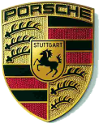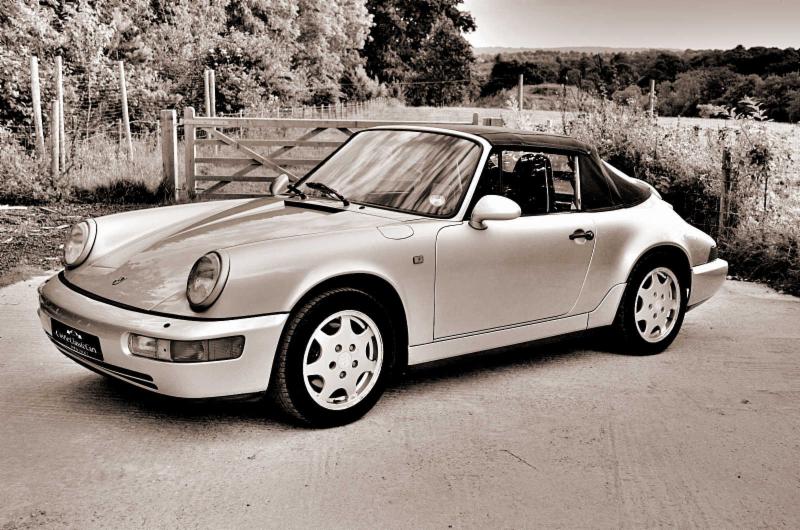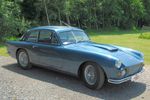Experts in classic and sports car sales
Whether you are buying or selling a classic or sports car, we can help you.
We are always seeking classic and sports cars to sell, particularly Porsche 911s. If you have a car to sell then please contact us.


A guide to the Porsche 964
Have a Porsche 964 to sell? Castle Classic Cars can help you.
Introduction
The Porsche 964 was one of the bigger developments of the 911 series cars. Production began in 1989 and introduced features such as 4 wheel drive and the sem-automatic Tiptronic gearbox to the 911 series. The car was available in Coupe, Targa and Cabriolet versions as per the Carrera 3.2. In addition there were various limited edition models, including lightweights, Turbo S, and RS versions. The Porsche 964 is becoming increasingly sought after, with late Turbos in particular commanding high prices.
Changes from the Carrera 3.2
A comparison with the previous Carrera 3.2 model :
- The 964 was an update to the 911 body, rather than a radical change as was initially planned.
- Introduction of 4 wheel drive to the 911 series in the Carrera 4, or C4 with 69 percent of the power going to the rear wheels to help make it feel more like a rear-wheel-drive car.
- With the introduction of the Carrera 4, the 2 wheel drive car now became known as the Carrera 2, or C2 for short.
- The body design changes reduced the drag coefficient from 0.39 to 0.32. A restyled front bumper and belly pan helped achieve this.
- Porsche claimed the car was 85 percent new as compared to the Carrera 3.2
- The Type M64/01 engine used in the 964 was now 3.6L compared to the 3.2L of the outgoing Carrera
- 2 spark plugs were used per cylinder to improve combustion and therefore lower emissions
- The wheelbase was unchanged from the Carrera 3.2
- The aerodynamic changes to the car reduced the overall length by 41mm when compared to the Carrera 3.2
- A new electrically operated rear spoiler that raised at 50mph, eliminating rear lift
- Coil springs at the rear instead of torsion bar. This is to allow for the driveshaft to the front differential of the Carrera 4
- The 964 Carrera 2 is approximately 140kg heavier than the Carrera 3.2. The Carrera 4 is another 100kg heavier still.
- The 964 gained approximately 16bhp, going from 231bhp to 247bhp.
- New dual mass flywheel to improve low speed transmission noises. The original item used in the earlier cars proved a little unreliable, being replaced by an improved version later on during production.
- New Tiptronic automatic option, with sem-automatic function allowing you to shift up and down gears without using a clutch. Available from 1990 onwards on the Carrera 2 only.
- ABS was now standard
- Power operated hood on cabriolets
Porsche 964 Carrera 4 vs Carrera 2
The obvious difference is the 4 wheel drive system on the Carrera 4 which was derived from the system used on the 959 supercar. The system has a bias towards the rear wheels to give the car a familiar 2-wheel drive feel. However the extra drive to the front wheels gives more grip in the corners, perhaps with a little less feel from the steering as a compromise.
There are other minor differences between the Carrera 4 and Carrera 2. The C4 brakes are asisted by the elctro-hydraulic system used to pressurise the front and rear differentials, whereas the C2 brakes use more conventional vacuum assistance. There are also some brake caliper differences between the C4 and C2 which varied during the 964s production run. The lack of a front differential in the C2 also means there is little more luggage space. The Carrera 4 works out at about 100kg heavier than the Carrera 2.
Porsche 964 Specifications
| Length | 4,250mm |
|---|---|
| Width | 1,652mm |
| Height | 1,310mm |
| Wheelbase | 2,272mm |
| Weight | 1,350kg (Carrera 2) / 1,450kg (Carrera 4) |
| Tyres | 205/55 ZR16 front, 225/50 ZR16 rear |
Porsche 964 Engine Specifications
| Type | M64/01 |
|---|---|
| Capacity | 3,600cc (flat six) |
| Bore x Stroke | 100mm x 76.4mm |
| Power | 247 bhp @ 6,100rpm |
| Torque | 228lb/ft@4,800rpm |
| Other | 2 spark plugs per cylinder |
Porsche 964 Performance
For any car you will find many different figures for performance. For the 964 there are varying reports for the 0-60mph time ranging from less than 5 seconds to over 5.5 seconds. So take any figures you see with a pinch of salt. The general consensus is that the tiptronic is perhaps 0.5s slower than the manual.
| 0-60mph | 5.5 seconds (manual) / 6.1 seconds (tiptronic) |
|---|---|
| Top speed | 162 mph (manual) / 159 mph (tiptronic) |
Porsche 964 Production Numbers
The Carrera 4 was introduced first in 1989 and the Carrera 2 followed later that year. The coupe was introduced first, with targas and cabriolet bodys arriving in 1990. The Tiptronic gearbox arrived in 1990.
The following are some approximate production number figures. In addition to these there are various limited edition models, such as the RS variants, RSR, Speedster and American Roadster.
| Total produced | 66,700 |
|---|---|
| Carrera 2 | 34,400 |
| Carrera 4 | 20,400 |
| Turbo | 7,000 |
| C2 & C4 Coupe | 34,000 |
| C2 & C4 Cabriolet | 15,300 |
| C2 & C4 Targa | 4,000 |
Porsche 964 Turbo
The Porsche 964 Turbo was introduced in the 1991 model line-up (M program). It used a derivative of the 3.3 litre engine from the previous 930 Turbo model. The engine produced 320 bhp @ 5,750 rpm and 332 lb-ft of torque at 4,500 rpm which was less power than the previous Turbo model due to having to meet more stringent emission standards. Nevertheless, the car still achieved a 0-60 mph time of 5.0 seconds and a top speed of 167 mph.
In 1993 the 3.6 litre Turbo version of the M64 engine was introduced. This now had 355 bhp @ 5,500 rpm and 384 lb-ft of torque available, bringing the 0-60 mph time closer to 4 seconds with a top speed of 174 mph. Approximately 1,600 of the 3.6 litre Turbos were built, making them the most desirable of the 964 Turbos.
Porsche 964 Chassis and Engine Numbers
The Porsche 964 was manufactured between 1989 and 1994. As with previous 911 generations, each year had a corresponding letter, from K (1989) to R (1994). There are many resources on the Internet which go into the engine and chassis numbers of 911s in detail. Briefly, the 964s chassis numbers for non-USA cars had the form:
WP0 ZZZ 96 Z <Y> S <4XXXXX>
The last 6 digits <4XXXXX> starting with a 4, is the unique serial number for that car. The letter <Y> between 96Z and the last S is the year letter (or program letter) and is one of K,L,M,N,P or R
The following tables show the serial number ranges for each year of production for non-USA cars.
| 1989 (K Program) | |
|---|---|
| Coupe | 40XXXX |
| 1990 (L Program) | |
|---|---|
| Coupe | 40XXXX |
| Targa | 41XXXX |
| Cabriolet | 42XXXX |
| 1991 - 1993 (M, N & P Program) | |
|---|---|
| Coupe | 40XXXX |
| Targa | 43XXXX |
| Cabriolet | 45XXXX |
| Turbo | 47XXXX |
| 1994 (R Program) | |
|---|---|
| Coupe | 40XXXX |
| Cabriolet | 45XXXX |
| Speedster | 455001 - 455581 |
| Turbo | 47XXXX |
The normally aspirated engines had an engine number starting in 62 and had this form:
62 <Y> <XXXXX>
The last 5 digits <XXXXX> are the unique serial number for that engine. The letter <Y> is the same year letter (or program letter) used in the chassis number and is one of K,L,M,N,P or R
The Turbo engine was similar, but started 61, and as it wasn't introduced until 1991 the year letter will be one of M, N, P or R.
61 <Y> <XXXXX>
























